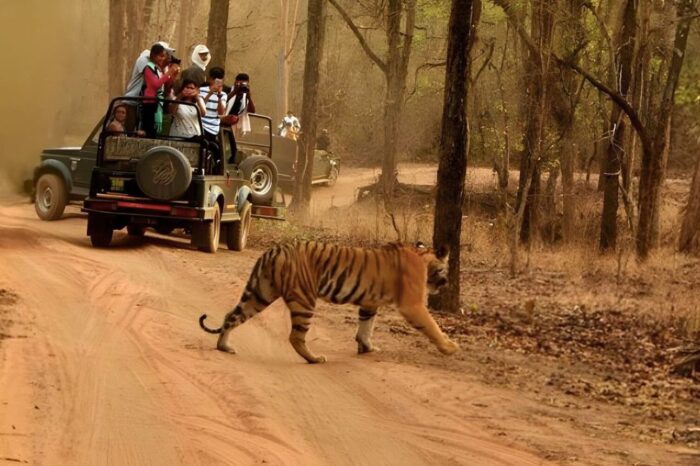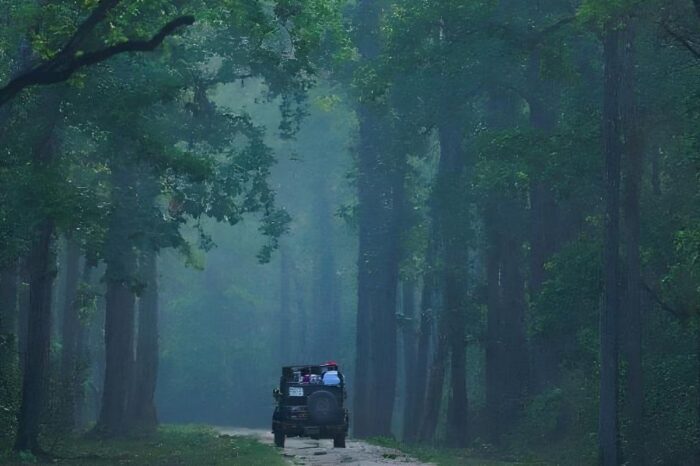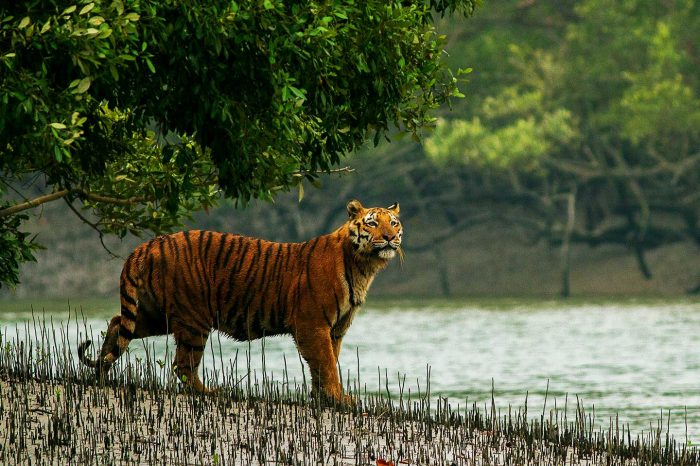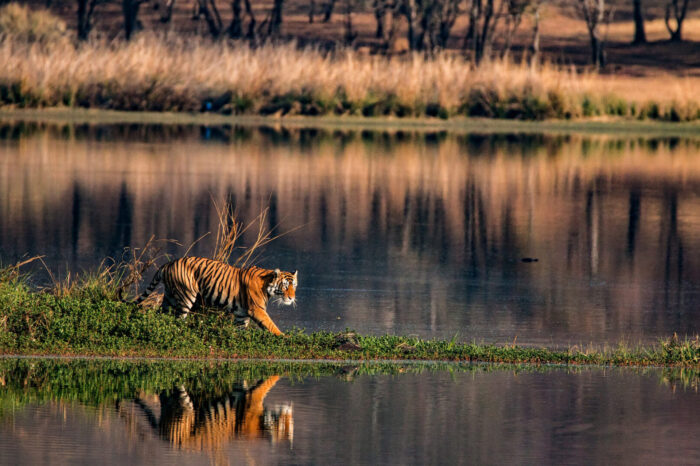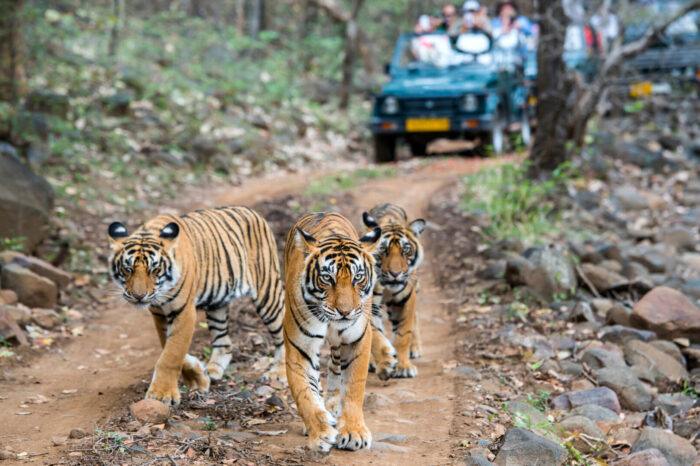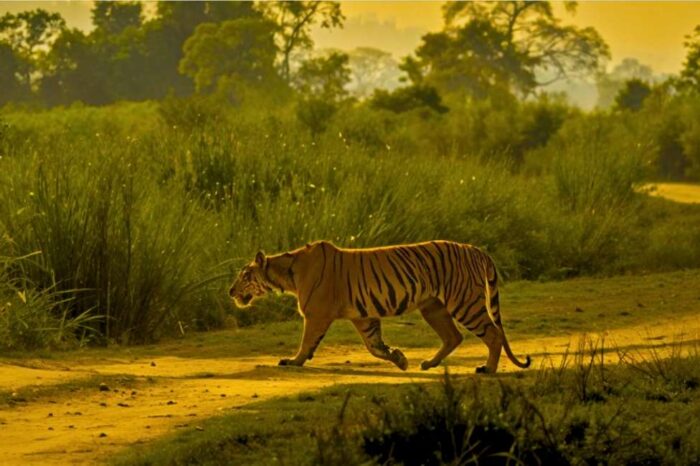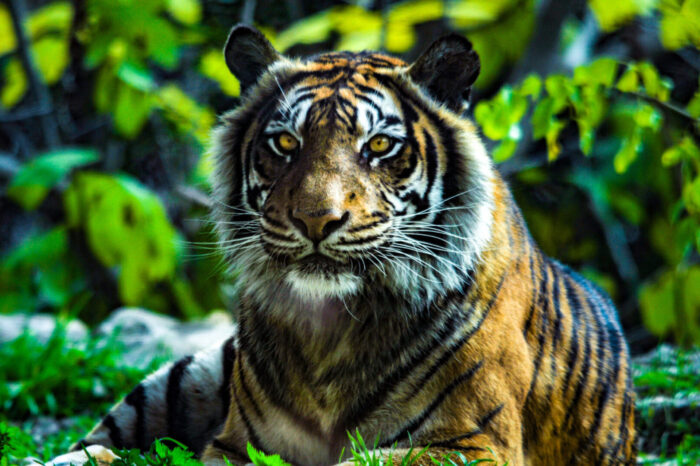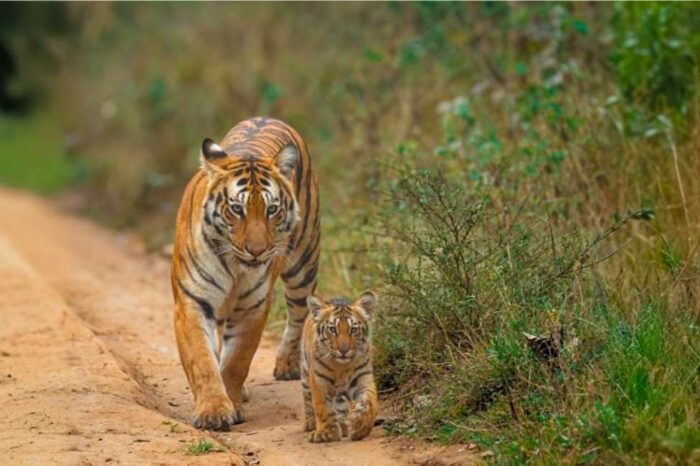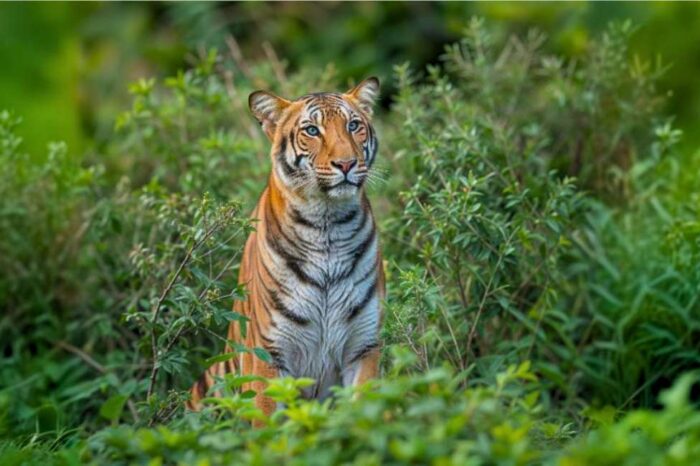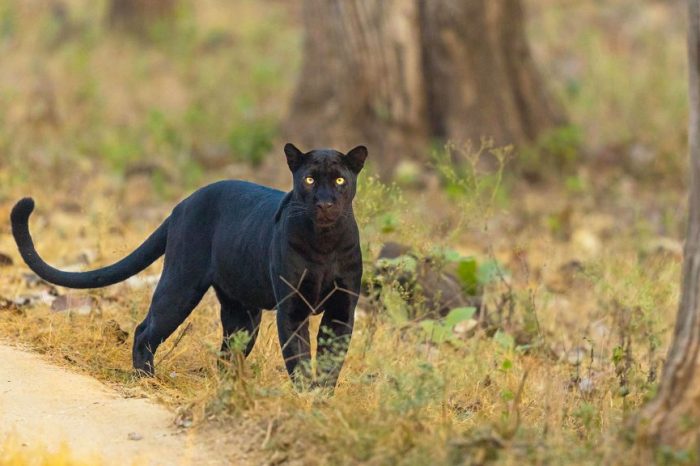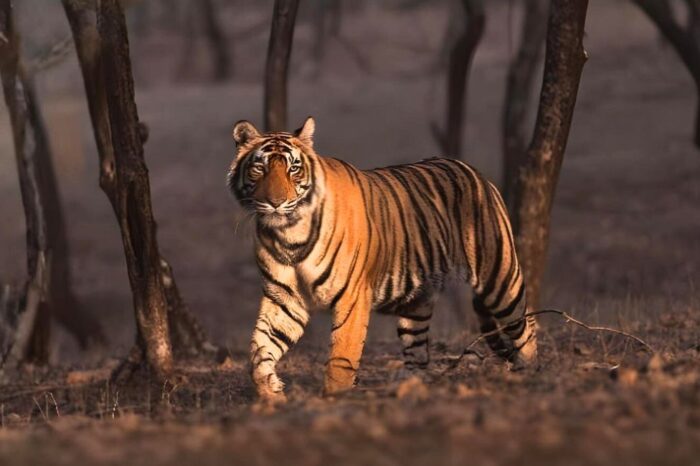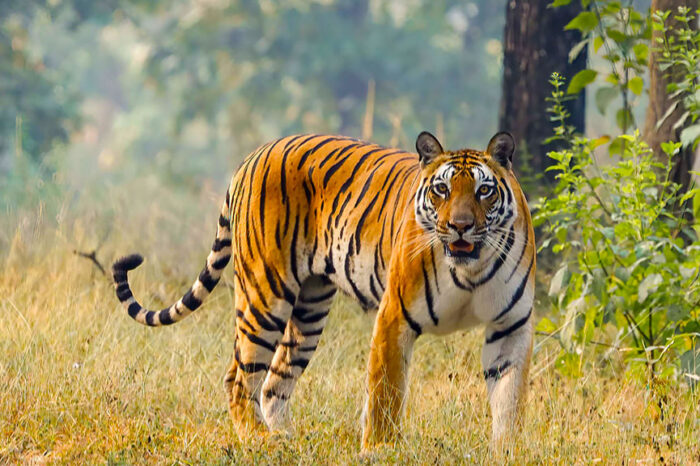- Home
- INDIA
- Offbeat India
- International
- Theme Tours
- Blogs
- Case Studies
- Plan Your Trip
Tiger Tourism
Tiger Tourism

MTDC Tadoba
Andhari Tiger Reserve, Largest Tiger Reserve, Tadoba Lake, Butterfly Garden, Jungle Safari

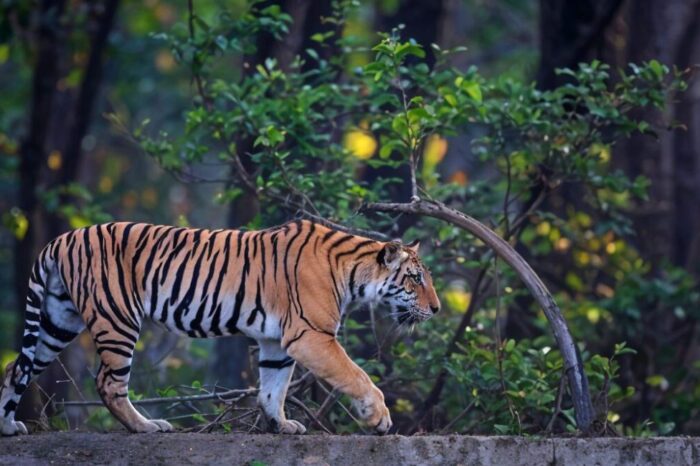
Tiger tourism offers an exhilarating journey into the heart of the wild, where the majestic big cats roam freely. Perfect for wildlife enthusiasts and adventure seekers, Tiger tourism provides an unforgettable experience of observing these magnificent creatures in their natural […]
Tiger tourism offers an exhilarating journey into the heart of the wild, where the majestic big cats roam freely. Perfect for wildlife enthusiasts and adventure seekers, Tiger tourism provides an unforgettable experience of observing these magnificent creatures in their natural environment. Venture through lush forests, serene landscapes, and discover the beauty of nature’s wilderness.
In the Footsteps of Tigers: Unveiling India’s Tiger Trails
Introduction
The jungle whispers secrets of a world untouched, where the tiger, the majestic ruler, roams with a silent, powerful grace. In the heart of India, these elusive creatures beckon adventurers and wildlife enthusiasts to embark on a journey like no other. This blog unveils the enigmatic world of tiger trails, guiding you through the dense forests and untamed lands of India’s most iconic tiger reserves. As tiger tourism gains popularity, these majestic habitats offer a unique opportunity to experience the wild like never before.
Iconic Tiger Reserves of India
Jim Corbett National Park: India’s First and Foremost Haven for Bengal Tiger Conservation
Jim Corbett National Park in Uttarakhand, established in 1936 as Hailey National Park, is India’s oldest national park. It was created to safeguard the endangered Bengal tiger and remains a cornerstone of tiger tourism. With diverse terrains of hills, marshy areas, riverine belts, expansive grasslands, and a sizable lake, it offers an unforgettable wildlife experience.
Ranthambore National Park: A Royal Legacy
Nestled in the arid landscapes of Rajasthan, Ranthambore National Park is a top destination for tiger tourism. Once a royal hunting ground, this park blends natural splendor with ancient forts and temples. The Bengal tiger reigns supreme here, drawing visitors from across the globe to its dry deciduous forests.
Tadoba National Park: A Biodiversity Treasure in Maharashtra
Known as the “Jewel of Vidarbha,” Tadoba National Park in Maharashtra is a prime site for tiger tourism. Its unique ecosystem supports a diverse range of flora and fauna, including tigers, leopards, and hyenas. Wildlife enthusiasts flock here to experience its vibrant biodiversity.
Bandhavgarh National Park: The Tiger’s Den
Located in Madhya Pradesh, Bandhavgarh National Park is a favorite destination for tiger tourism due to its high tiger density and visibility. Its steep ridges and open meadows create the perfect habitat for these magnificent creatures, offering photographers and enthusiasts unparalleled opportunities to observe them in the wild.
Kanha National Park: Inspiration Behind “The Jungle Book”
Kanha National Park, also in Madhya Pradesh, is a must-visit for tiger tourism enthusiasts. It is renowned for its thriving population of Bengal tigers, Indian leopards, and Barasingha. Its sal and bamboo forests, rolling grasslands, and meandering streams bring Rudyard Kipling’s “The Jungle Book” to life.
Pench National Park: A Wildlife Sanctuary Steeped in ‘Jungle Book’ Lore
Straddling Madhya Pradesh and Maharashtra, Pench National Park is another hotspot for tiger tourism. Visitors can enjoy sightings of Bengal tigers alongside species like Gaur, Cheetal, and Nilgai. Its association with “The Jungle Book” adds to its allure.
Kaziranga National Park: A Conservation Success Story Beyond Rhinos
While famed for its one-horned rhinoceroses, Kaziranga National Park in Assam is also a thriving hub for tiger tourism. Its well-preserved habitat offers a chance to observe tigers amidst an ecosystem teeming with life, making it a conservation success story.
Sundarbans National Park: A Mystical Realm
The Sundarbans, a UNESCO World Heritage Site, is a unique destination for tiger tourism. Known for its swimming tigers, this mangrove ecosystem offers a thrilling and challenging safari experience, showcasing the adaptability of tigers to saline environments.
Bandipur Tiger Reserve: South India’s Pride
In Karnataka, Bandipur Tiger Reserve is an essential part of the Nilgiri Biosphere Reserve. A significant tiger population, combined with its lush forests, makes it a favorite for tiger tourism. Visitors can also spot elephants and various bird species in this biodiverse sanctuary.
Kabini Wildlife Sanctuary: A Pristine Habitat for Tigers
Kabini Wildlife Sanctuary, part of Nagarhole National Park in Karnataka, is a gem for tiger tourism. It offers sightings of Bengal tigers, leopards, and elephants, all set against the picturesque backdrop of the Kabini River.
Similipal Tiger Reserve: Odisha’s Wildlife Gem
Similipal Tiger Reserve in Odisha is another jewel for tiger tourism. Home to Bengal tigers, elephants, and leopards, it provides visitors with immersive safaris and a chance to witness nature’s beauty up close.
Manas Tiger Reserve: Assam’s Pristine Wilderness
Manas Tiger Reserve, a UNESCO World Heritage Site in Assam, is a cornerstone of tiger tourism in the northeast. Its diverse habitats support Bengal tigers, pygmy hogs, and wild water buffalo, offering visitors an enchanting wildlife experience.
Satpura Tiger Reserve: Madhya Pradesh’s Hidden Gem
For offbeat tiger tourism, Satpura Tiger Reserve offers a unique safari experience. Its rugged terrain, dense forests, and pristine river systems provide an ideal habitat for tigers, making it a hidden gem among India’s reserves.
A Day in the Life of a Tiger Tracker
Joining a tiger tracker on their daily expedition is an unforgettable part of tiger tourism. These experts interpret the forest’s subtle clues—footprints, scratches, and calls—to locate tigers. Their stories of close encounters and tracking adventures bring the wild to life, fostering a deep appreciation for the delicate balance of ecosystems. For any tiger tourism enthusiast, accompanying a tracker is an unparalleled experience.
Photography and Tiger Spotting Tips:
Capturing the Essence of the Wild
Capturing a tiger in its natural habitat is a dream for wildlife photographers, and it requires a unique blend of patience, skill, and respect for the animals.
Timing is Everything:
Early mornings and late afternoons are when tigers are most active. The soft, golden light during these hours not only enhances your photographs but also increases the chances of tiger sightings.
Silence and Stillness:
Tigers are highly sensitive to noise and movement. Maintaining silence and minimising any sudden movements is essential to avoid disturbing these majestic creatures.
Use the Right Equipment:
Professional wildlife photographers often use telephoto lenses (300mm and above) to capture tigers from a safe distance. A good tripod is also crucial for stability, especially in low-light conditions.
Understanding Tiger Behavior:
Learning about tiger behaviour from experienced guides is invaluable. They can anticipate the tiger’s movements based on its body language, helping you position yourself for the perfect shot.
Respect Wildlife Ethics:
Renowned photographers like Steve Winter and Sudhir Shivaram emphasise the importance of ethical wildlife photography. It involves maintaining a safe distance, not baiting animals for photographs, and leaving no trace of your presence.
Storytelling Through Photography:
Photographers like Nick Brandt and Anup Shah are celebrated for their ability to tell compelling stories through their images. Capturing not just the tiger but also its environment and interactions can elevate your photography to another level.
Editing and Post-processing:
Post-processing skills are essential to enhance the final image. Photographers like Art Wolfe are known for their mastery of editing techniques that bring out the best in wildlife photography.
Best Times for Tiger Sightings
For travellers seeking the awe-inspiring experience of spotting tigers in the wild, timing can make all the difference. To maximise your chances of witnessing these majestic creatures, here’s a guide to the best times for tiger sightings
Early Mornings (Dawn):
The first light of day is a prime opportunity for tiger encounters. As the sun rises, tigers become active, emerging from their resting spots to start their day. The cool, crisp air and soft morning light create an ideal setting for wildlife photography.
Late Afternoons (Dusk):
Similar to dawn, late afternoons offer another window of opportunity. As the day cools down, tigers venture out in search of prey or water sources. The enchanting golden hues of the setting sun add to the magical atmosphere.
Winter Months:
The dry, winter months of November to March are often considered the best time for tiger sightings. With reduced foliage and water sources drying up, tigers are compelled to gather around the remaining water bodies, increasing your chances of spotting them.
Post-Monsoon (October):
Just after the monsoon season, in October, the landscape is lush and green, making it an excellent time for tiger sightings. The rejuvenated vegetation attracts herbivores, drawing tigers in search of prey.
The Bigger Picture: Tigers and Ecology
The existence of tigers is intrinsically linked to the health of the ecosystem. As apex predators, they maintain the balance between prey species and the vegetation upon which they feed. Understanding this interconnectedness is crucial in appreciating the role of tigers beyond their charismatic appeal.
The Ethics of Tiger Spotting
In the excitement of spotting a tiger, it’s crucial to maintain an ethical approach to wildlife tourism. This section would delve into the principles of responsible tourism – from maintaining a safe distance from the animals to understanding the impact of human presence on their natural behaviour. It’s about fostering a relationship of respect and awe, rather than intrusion and dominance.
Local Stories and Tiger Lore
The narrative of the tiger is intricately entwined with the cultural tapestry of India, representing a symbol of both reverence and fear. Across the diverse landscapes of the country, local tales and folklore have emerged, celebrating the tiger as a majestic and enigmatic creature. These narratives not only highlight the awe-inspiring nature of the tiger but also showcase the deep connection between humans and wildlife.
Symbol of Gods and Goddesses:
In Hinduism, the tiger is associated with various deities, such as Goddess Durga, who rides a tiger and symbolises feminine power and protection. This divine connection underscores the tiger’s significance in Indian spirituality and mythology.
Protector and Predator:
Local stories often portray the tiger as a protector of villages, guarding them against other wildlife and intruders. At the same time, these tales emphasise the tiger’s role as a formidable predator, maintaining a delicate balance in the ecosystem.
Cultural Identities:
The tiger’s presence has shaped the cultural identities of many indigenous communities and tribes across India. Their beliefs and traditions are intertwined with tiger lore, influencing rituals, dances, and art forms.
Conservation Catalyst:
Through interviews with local communities and forest guides, it becomes evident that these stories play a vital role in conservation efforts. They instil a sense of responsibility and pride in protecting the tiger’s habitat, as it is not only a part of their culture but also a symbol of India’s natural heritage.
Awareness and Education:
The stories surrounding tigers serve as powerful tools for raising awareness about the importance of tiger conservation. They bridge the gap between urban and rural populations, fostering a shared commitment to preserving these magnificent animals and their habitats.
In summary, the rich tapestry of local stories and tiger lore in India reflects the multifaceted relationship between humans and tigers. These narratives not only celebrate the tiger’s significance but also act as catalysts for conservation, ensuring that the cultural heritage and natural heritage of India continue to thrive side by side.
Tiger Tourism: Challenges and Triumphs
Despite the increasing popularity of tiger tourism, it faces its share of challenges, from habitat loss to human-animal conflicts. This part of the blog would shed light on these issues while also focusing on the success stories – the triumphs of conservation efforts, the increase in tiger populations, and how sustainable tourism can play a pivotal role in conservation.
The Tiger Safari: Do’s
When embarking on a tiger safari in India, it’s essential to follow certain dos and don’ts to ensure both your safety and the well-being of the wildlife. Here are some guidelines:
Follow the Guide’s Instructions:
Always listen to and follow the instructions of your safari guide. They are experienced and trained to ensure a safe and enjoyable wildlife viewing experience.
Maintain Silence:
Keep noise to a minimum during the safari to avoid disturbing the animals and maximize your chances of spotting wildlife.
Stay Inside the Vehicle:
For your safety and the safety of the animals, remain inside the designated safari vehicle at all times. Do not get down unless explicitly allowed in designated areas.
Respect Wildlife’s Space:
Maintain a safe distance from wildlife. Avoid getting too close, especially with predators like tigers. Respect their natural behavior and habitat.
Pack Essentials:
Bring essentials like water, sunscreen, insect repellent, and appropriate clothing for the weather conditions.
Be Patient:
Wildlife sightings are not guaranteed, and patience is key. Spend time observing the surroundings, and you may be rewarded with unexpected encounters.
The Tiger Safari: Don’ts
No Flash Photography:
Avoid using flash photography, as it can disturb and stress the animals. Follow the guidelines set by the park authorities regarding photography.
Don’t Feed the Animals:
Never attempt to feed the wildlife. It disrupts their natural behavior and can be harmful to their health.
Avoid Sudden Movements:
Sudden movements can startle animals. Move slowly and calmly to minimize disturbances.
No Littering:
Dispose of litter responsibly. Keep the environment clean and respect the park’s rules regarding waste disposal.
No Smoking:
Smoking is often prohibited in wildlife areas due to the risk of starting fires. Follow park regulations regarding smoking.
Do Not Tease or Taunt Animals:
Avoid any behavior that might provoke or disturb the animals. Maintain a respectful distance and observe them in their natural state.
Tigers in Indian Culture and Mythology
The tiger has been a symbol of power and grace in Indian mythology and culture. This section would explore the legends and folklore surrounding the tiger, highlighting its significance in various cultural practices and beliefs. It’s a journey through the stories that have shaped the reverence for this majestic animal in India.
Conservation Efforts and Success Stories
Despite the challenges of habitat loss and poaching, there are inspiring success stories in tiger conservation. This part of the blog would focus on the efforts made by national parks, wildlife sanctuaries, and conservationists. Highlighting these stories not only showcases the triumphs but also emphasises the ongoing need for conservation initiatives.
Tiger conservation has seen remarkable success stories, particularly in countries like India and Nepal. India, home to a significant population of Bengal tigers, has implemented various conservation strategies that have played a pivotal role in reversing the path to extinction for these majestic creatures . Notably, national parks like Kanha, Bandhavgarh, and Kaziranga have been at the forefront of these efforts, combining strict anti-poaching measures with habitat conservation and community engagement.
Nepal’s commitment to tiger conservation is another success story worth mentioning. Through dedicated efforts in habitat management and community-based conservation programs, Nepal has seen a commendable increase in its tiger population
These successes are the result of coordinated efforts involving government policies, conservationists, and local communities. They highlight the significance of tigers as keystone species in maintaining ecological balance and cultural heritage However, the need for ongoing conservation initiatives remains critical, as threats like habitat fragmentation, human-wildlife conflict, and illegal wildlife trade still pose significant challenges.
TOFTigers
TOFTigers, also known as Travel Operators for Tigers, plays a significant role in tiger conservation, primarily through promoting sustainable tourism and wildlife conservation in India. Their activities are multifaceted:
Advocacy and Planning:
TOFTigers works as a changemaker, collaborating with governments, communities, and the private sector. They focus on advocating and planning for the protection and conservation of wildlife and their habitats.
Promotion of Responsible Tourism:
A key part of their mission is highlighting the importance of responsible tourism as a force for nature conservation. This includes rural livelihoods and poverty reduction, underlining the socio-economic benefits of wildlife conservation.
Charity Alliance for Ecological Sustainability:
As a sustainable tourism and wildlife conservation charity alliance, TOFTigers is dedicated to improving the ecological and economic sustainability of wildlands. This includes efforts to create a balance between tourism activities and the conservation needs of wildlife, especially tigers.
Celebrating Conservation Milestones:
TOFTigers actively celebrates significant conservation milestones, such as the 50th anniversary of the Tiger Project, which shows their commitment to long-term conservation efforts.
Wildlife Tourism Awards:
They organise events like TOFTigers Wildlife Tourism Awards, recognizing and rewarding efforts in wildlife tourism and conservation, thereby encouraging best practices in the industry
Supporting Conservation Campaigns:
TOFTigers supports various campaigns aimed at increasing tiger populations in India, indicating their active involvement in on-ground conservation activities .
Through these activities, TOFTigers plays a critical role in connecting tiger conservation with sustainable tourism, thereby creating a mutually beneficial relationship between wildlife protection and community development.
Personal Experiences and Tips
Drawing from personal anecdotes and experiences, this section will offer practical advice for aspiring wildlife photographers and enthusiasts. Tips on camera gear, etiquette in the wild, and patience in awaiting the perfect sighting can greatly enhance the safari experience.
Conclusion
Exploring India’s tiger trails is more than just a wildlife adventure; it’s a journey into the heart of nature. As we tread softly in the footsteps of these majestic creatures, we’re reminded of the delicate balance that sustains our natural world. Each tiger sighting is a privilege, a moment where time stands still, and we come face-to-face with the wild’s true essence. It’s a journey that asks for patience, respect, and a deep sense of wonder, reminding us of our place in the natural world and our duty to protect these magnificent creatures.
Experiences
- Waterfalls of ChhattisgarhOctober 29, 2025
- Jewellery and Handicrafts of ChhattisgarhAugust 12, 2025
- Heritage Properties of ChhattisgarhAugust 12, 2025
- Tribals of ChhattisgarhAugust 12, 2025
- Amarkantak TourJune 17, 2025
- Waterfalls of Chhattisgarh
Call
98742 84569
98743 61951
Mon-Sat 11.00AM-07.30PMNewsletter
Rate & Review Us
Contact Info
- +91 98742 84569
- experience@ocean6.in
- 16, Suren Tagore Rd, Ekdalia, Ballygunge, Kolkata, West Bengal 700019
- Mon - Sat : 11.00 AM - 7.30 PM
Sunday : CLOSED
Newsletter
Quick Links
